Hair — it’s our crowning glory, a canvas for self-expression and, sometimes, a bit of a puzzle. Everyone’s hair is unique, and understanding its intricacies is the key to achieving enviable locks. Your hair is a reflection of your personality and style. It’s a canvas for experimentation and deserves the best care and attention.
That’s why understanding your hair type is crucial. In this comprehensive guide, we’ll explore different hair types, how to classify them and the best practices for caring for each type. Whether you have straight, wavy, curly or coily hair, we’ve got you covered with tips and techniques to keep your locks looking their best with professional hair care products. Whether you’re trying to determine your hair type or want to help your clients better understand their hair types, keep reading to find all the information you need.
What Is Hair Typing?
Hair typing classifies hair based on its texture, curl pattern and other characteristics. This classification is a critical first step in tailoring your hair care regimen to suit your unique needs. Not all hair is created equal, and the path to healthy, beautiful locks begins with understanding your hair type.
The hair typing system categorizes hair into types 1, 2, 3 and 4, with further subcategories to describe variations within these groups. The straightest hair falls under type 1, while type 4 includes coily hair. Let’s take a closer look at each type.
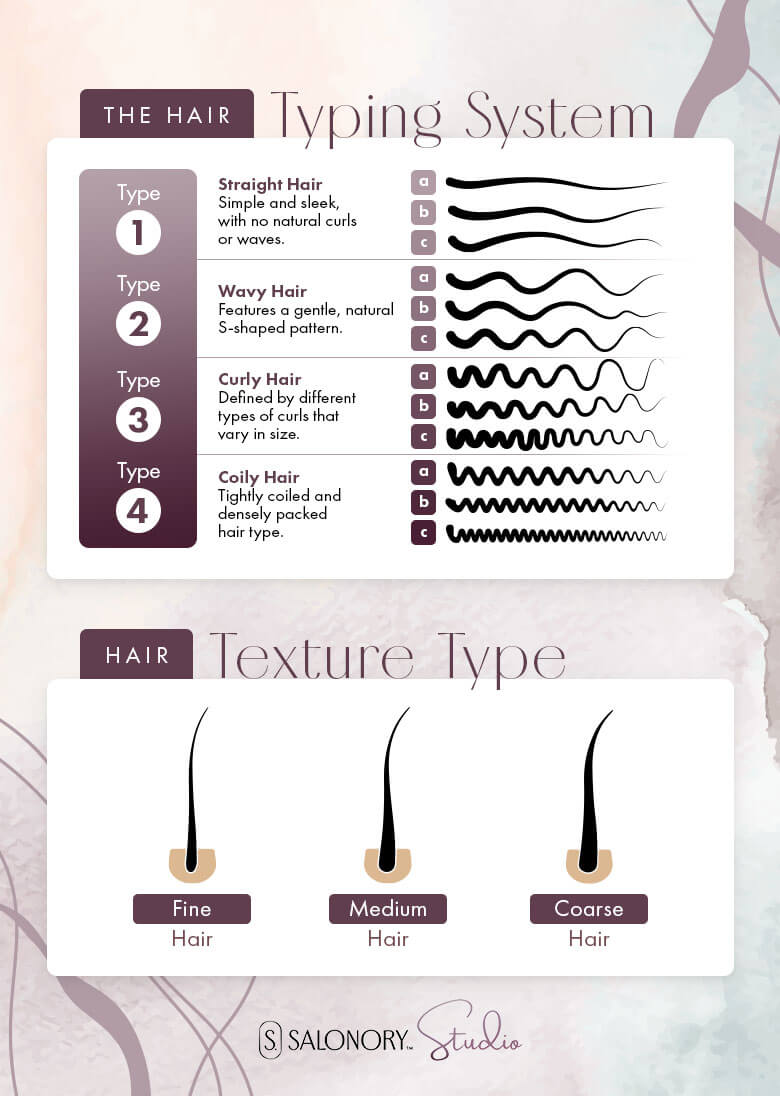
Type 1: Straight Hair
Straight hair is simple and sleek, with no natural curls or waves. If you have type 1 hair, your strands typically fall straight from the root to the tip.
Care Tips
Consider using volumizing shampoos and conditioners that give your hair some extra body. Choosing lightweight, non-greasy styling products is also a good idea to avoid weighing down your hair.
Careful styling gives flat hair a much-needed boost. Techniques like blow drying with a round brush add volume and create the illusion of natural movement. Teasing at the crown of your head is another method of adding volume and giving your hair a fuller appearance.
Type 2: Wavy Hair
Wavy hair has a relaxed, carefree charm. It has a gentle, natural S-shaped pattern, giving it a subtle but noticeable wave. This type sits in the middle between straight and curly, and it’s known for its versatility and effortless style.
Care Tips
The secret to caring for wavy hair is embracing and enhancing your natural waves. Given its natural bounce, wavy hair can be prone to losing its shape when weighed down. Choose lightweight shampoos and conditioners to keep your locks looking their best.
Avoid heavy styling products that can straighten or flatten your waves. Instead, opt for those that define and emphasize your waves to give your hair a lively, beachy look.
Type 3: Curly Hair
Curly hair is a celebration of texture and bounce. It’s defined by different types of curls that often vary in size, creating a visually striking and dynamic look. Type 3 hair is all about embracing those natural ringlets and making them the centerpiece of your style.
Care Tips
Curly hair thrives on moisture and hydration, so use shampoos and conditioners designed to add and retain moisture. Regular deep conditioning treatments can help keep frizz at bay. Use styling products that define your curls, giving them structure and bounce.
Invest in anti-frizz oil and serums. Avoid over-styling and heat damage, as these can exacerbate frizz.
Type 4: Coily Hair
Coily hair is a unique, tightly coiled and densely packed hair type. It’s known for its zigzag pattern and often coarse appearance. Despite its texture, with proper care, coily hair can be incredibly beautiful and captivating.
Care Tips
Coily hair thrives on moisture retention. Deep conditioning treatments, leave-in conditioners and natural oils can keep your coils hydrated. Invest in a salon conditioner to ensure the best results. Detangling will take patience and time, but it’s crucial for managing your hair without causing breakage.
Understanding Hair Texture
Now that we’ve discussed hair types, let’s talk about hair texture. Your hair’s texture plays a crucial role in determining your hair type, too:
- Fine Hair: Fine hair has strands that are narrow in diameter, making it inherently delicate. It can be prone to breakage but often boasts a silky texture that feels like spun silk. Products designed to add volume without weighing down the hair are the go-to for those with fine locks. Lightweight mousse and volumizing sprays can create the illusion of thicker, fuller hair without compromising its natural grace.
- Medium Hair: Medium hair sits comfortably between fine and coarse, offering versatility in styling. You can embrace its natural texture or straighten it for a sleek, polished look. When it comes to product selection, the choices are vast.
- Coarse Hair: Coarse hair has a thicker strand diameter, making it robust and sometimes challenging to manage. It craves deep hydration to tame its unruly nature. Oils, rich creams and leave-in conditioners are essential to lock in the much-needed moisture. These products soften coarse hair and enhance its natural luster and manageability.
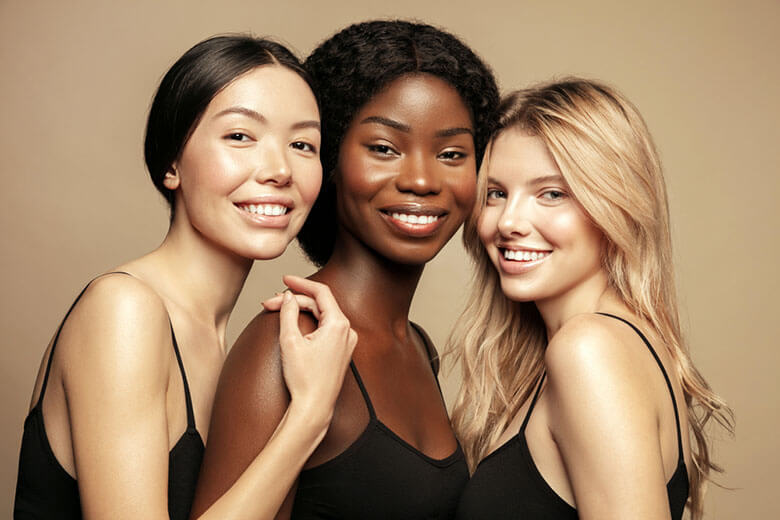
Determining Your Hair Type
Not sure what your hair type is? Want to show your clients easy ways to determine their hair types? Here are a few techniques for determining hair type.
The Water Test
The easiest way to get a basic idea of your hair type is to try the water test. Here’s how it works: wash your hair and let it air dry without any product. If it dries straight, you likely have straight hair. If it dries with a slight wave, you have wavy hair. If it forms defined curls, you have curly hair, and if it shrinks into tight coils, your hair type is coily.
The water test provides a quick general overview of your hair’s characteristics. However, remember that the final verdict on your hair type may depend on other factors like porosity.
The Strand Test
The strand test is another DIY method for determining hair type. Take a single strand of your hair and examine it closely. Is it thin and fine, or is it thick and coarse? Does it have a natural curl or wave pattern? These observations can help you identify the basic characteristics of your hair.
When using this technique, remember that hair can vary in texture and curl pattern, even on the same head. It’s normal to have a mix of hair types and characteristics. Understanding these subtleties will guide you in choosing the right products and styling methods.
Professional Consultation
While at-home tests are informative and can provide a good starting point, a professional can provide more accurate insights into your hair type. Your stylist has the expertise to determine your hair type based on multiple factors, including density, texture and porosity. They will also recommend personalized products and routines aligning with your hair’s needs.
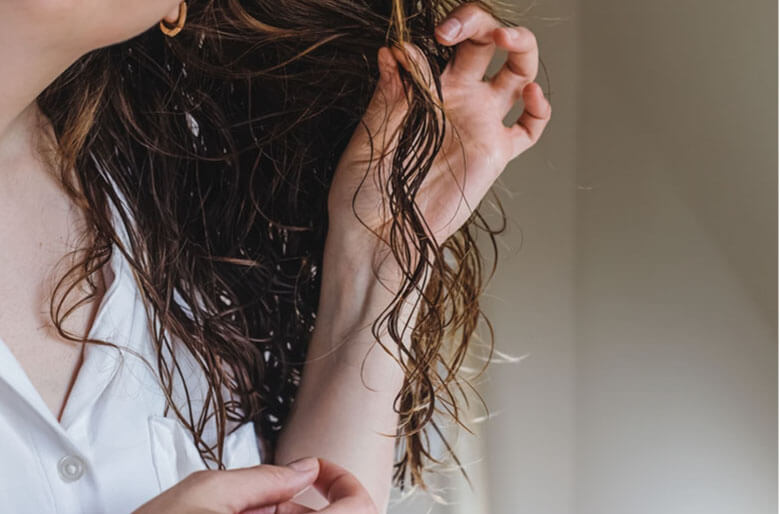
Understanding Hair Porosity
Another factor to consider when determining hair type is hair porosity. Porosity is your hair’s ability to absorb and hold moisture. It’s a critical factor that affects how your hair looks and feels. There are three porosity levels: low, normal and high.
Low Porosity
Low-porosity hair has a tightly sealed cuticle layer that resists moisture absorption. It often appears shiny and can be challenging to hydrate.
Normal Porosity
Normal-porosity hair has a balanced cuticle layer, allowing it to absorb and retain moisture effectively. It’s typically smooth, shiny and easy to manage.
High Porosity
High-porosity hair has a highly porous cuticle layer, making it prone to absorbing excess moisture. It may appear frizzy but typically air dries rather quickly.
Understanding your hair’s porosity level is crucial because it determines how you should approach your hair care routine.
Determining Hair Porosity
You can do tests at home to determine your hair’s porosity. The most common ones involve using a glass of water or observing how your hair reacts to moisture.
The Water Test
Take a clean strand of hair and place it in a glass of water. If the strand sinks, your hair has high porosity. If it floats near the middle, it has normal porosity. If it stays at the surface, it has low porosity.
The Slip ’n’ Slide Test
Run your fingers up and down a strand of your hair. If it feels smooth, your hair has normal porosity. If it feels rough, it’s high porosity, and if it feels slippery, it’s low porosity.
The Spray Bottle Test
Spray a section of your hair with water. Your hair has low porosity if the water beads up and sits on the surface. If it’s quickly absorbed, your hair has high porosity.
Understanding your hair’s porosity level and tailoring your routine is essential for maintaining its beauty and health. It helps you choose the right products and techniques that work with your hair rather than against it.
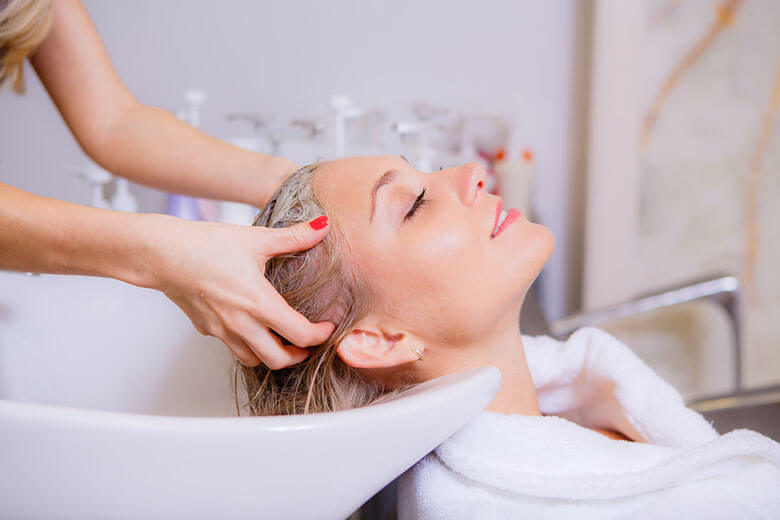
Understanding Scalp Condition and Moisture
While we’ve covered all things hair, it’s important to discuss scalp health as well. A healthy scalp is the foundation for healthy hair, and its condition is just as important as the hair itself. Dry or oily scalps, dandruff and sensitivity are all factors that can impact your hair. Here are a few of the most common scalp issues and how to treat them:
Dry Scalp
A dry scalp can cause itchiness and flakiness. Opt for shampoos and conditioners with moisturizing properties. Also, consider a gentle scalp massage with a nourishing oil to alleviate dryness.
Oily Scalp
An oily scalp can make hair appear greasy and flat. Clarifying shampoos and lightweight conditioners help control excess oil production, leaving hair fresh and voluminous.
Dandruff
If you’re dealing with dandruff, look for anti-dandruff shampoos containing ingredients like salicylic acid or zinc pyrithione. These ingredients effectively combat dandruff, leaving your scalp healthy and flake-free.
Sensitivity
Sensitive scalps require tender care. Choose hypoallergenic and fragrance-free hair products to minimize irritation. These products soothe the scalp while maintaining hair health. Talk to a dermatologist if your scalp is extremely sensitive.
Finding The Right Hair Products
The products you use on your hair can either enhance its natural beauty or harm it. Choosing the right products for your hair type is crucial. However, there are no one-size-fits-all solutions. Everyone’s hair has different needs, but there are certain things to remember when shopping for hair care products.
- Ingredients: Pay attention to the ingredients in your hair care products. Look for formulations free from harmful chemicals like sulfates and parabens.
- Quality: Invest in high-quality hair care products. They may cost a bit more, but they typically contain better ingredients and are more effective. And since they are more effective, it usually takes less product to achieve the desired results. High-quality products make a noticeable difference in your hair’s health and appearance.
- Brand Reputation: Choose products from reputable brands dedicated to hair health. Read reviews and do your research to select products that align with your hair type and specific needs.
Your hair care routine is only as good as the products you use. Paying attention to the ingredients, quality and brand reputation can significantly impact your hair’s health and beauty. If you’re a stylist, help your clients determine which products are right for their unique needs.

Wrapping Up
Understanding and celebrating your hair type is the first step toward achieving the healthy, beautiful locks you crave. Your hair type is unique to you, and with the right care and attention, it can become your most beautiful accessory.
Remember that your hair is an integral part of your identity. Embrace it, love it and, most importantly, take care of it. Your hair is a testament to your uniqueness, so wear it proudly.
Determining your hair type and adopting the right hair care routine can be a transformative experience. It’s a journey of self-discovery, self-expression and self-care. With the knowledge and tips provided above, you can embark on your hair care adventure. Enjoy the process, and may your locks reflect your inner beauty and confidence.
Image Credits
Artnizu/Shutterstock.com
gpointstudio/Shutterstock.com
AnikaNes/Shutterstock.com
Chiociolla/Shutterstock.com
anna1195/Shutterstock.com
art4stock/Shutterstock.com
Beauty Agent Studio/Shutterstock.com






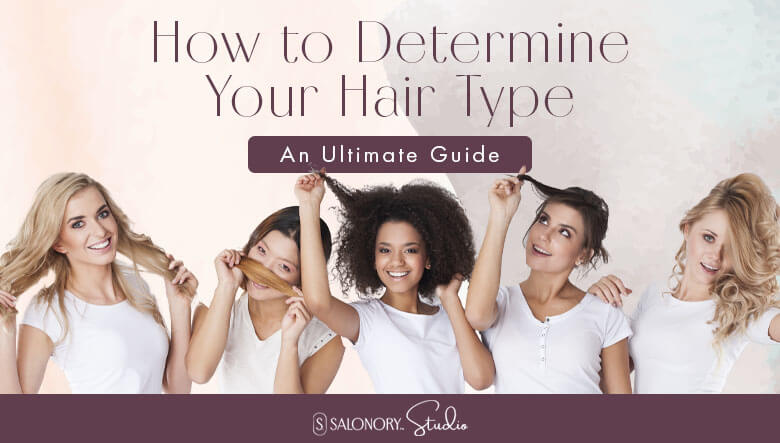






Share Your Feedback